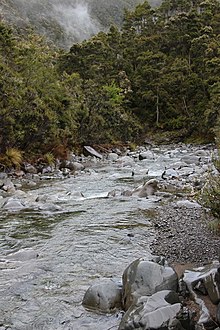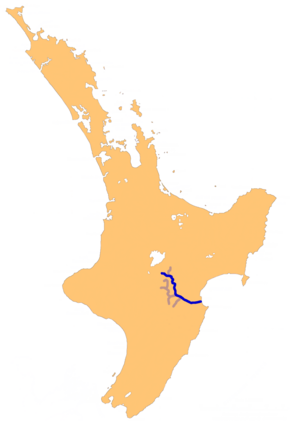Ngaruroro River
| Ngaruroro River | |
|---|---|

Ngaruroro River in Kawekas
|
|
| Country | New Zealand |
| Basin features | |
| Main source | Kaimanawa Range |
| River mouth |
Hawke Bay 0.0 metres (0 ft) |
| Physical characteristics | |
| Length | 164 kilometres (102 mi) |
The Ngaruroro River is located in the eastern North Island of New Zealand. It runs for a total of 164 kilometres southeast from the Kaweka Range, Kaimanawa Range and Ruahine Range and then east before emptying into Hawke Bay roughly halfway between the cities of Napier and Hastings, near the town of Clive (drainage area 2,000 square kilometres above Tutaekuri River confluence). The river is mostly a single-thread channel down to Whanawhana (45 kilometers from the coast), flowing through a greywacke rock gorge. Below Whanawhana, the river opens to wide braided channel. The Ngaruroro shares a river mouth with the Tutaekuri, Clive River and Muddy Creek. The meeting of these rivers forms the Waitangi Estuary.
The Ngaruroro is one of several rivers that helped form the alluvial Heretaunga Plains at the south end of the coast of Hawke Bay. The course of the Ngaruroro has changed several times, originally flowing down what is now the Clive River. It changed to much of its present course in 1867 during a major flood. In 1969, the bottom 4 km of river was diverted more directly to the coast (near Pakowhai Road) in an effort to reduce flooding. The Karamu and Clive remain as rivers, but drain a smaller catchment.
About 40% of the catchment is pasture, and 55% native forest.
The upper-Ngaruroro drains the Kaweka Forest Park and it is used for trout fishing (mostly rainbow), rafting, tramping and deer hunting.
The Ngaruroro River recharges freshwater to the Heretaunga groundwater aquifer (in the order of 4 cubic metres per second). This aquifer feeds several streams in the area (e.g. Raupare, Irongate), in addition to pumping that supports extensive orchards of the Heretaunga Plains. Eventually the aquifer discharges to the sea in submarine springs some 20 km off the coast.
...
Wikipedia

